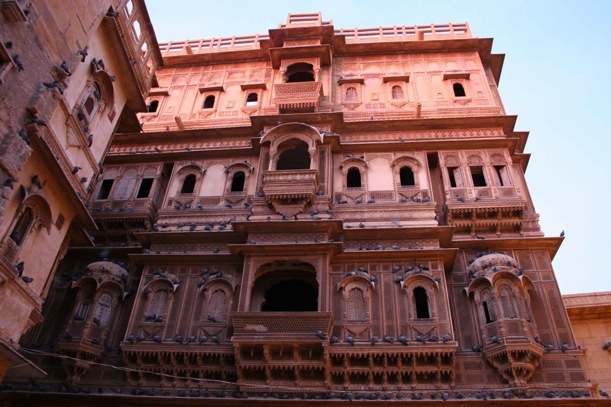850 Year Old City

Jaisalmer
is another special place in India. It’s the “golden city” because
it is made almost entirely of sandstone and consequently glows red at
both sunset and sunrise. it was situated along the Silk Route and
grew rich by taxing the caravans.
In
fact, it became so rich that its ruler built an ornate fort on top of
the hill in 1156. In the 19th century rich locals would build
their own mini-castles: ornately carved havelis in the middle of the city. Today almost every house has some form of a carved sandstone balcony or frontispiece.
We
arrived after a six hour bus ride. The ride itself was a great
chance to experience the “real India”: an overcrowded bus where I was
elbowed and kicked as I listed to a few musicians play their
traditional music that was occasionally joined by the odd belch.
People carried almost everything with them; the oddest thing anyone
brought on board: a (at least) 50 year old sewing machine.
We
were met at the bus station by our new friend Kailash from the Moti
Palace Hotel. Thank god-as another tourist on the bus didn’t have
a place pre-arranged and she was mobbed by at least 15 people all
offering her “the best guest house in town”. Incidentally,
everyone we met tried to tell us how were staying at the wrong place
but their friend/cousin/brother had the best guest house.
Anyways,
we arrived at the place and what a view! The photo above was
actually taken from the window of the 500 year-old, mud floored room
that we were staying. It’s unbelievable where you can stay here
in India (by the way, Indians hate staying in this sort of room: they
want air conditioning and colour television).
We took in a couple of havelis around town and they were some of the most luxurious houses I’ve ever seen. One (Salim Singh-Ki haveli)
was the old home of a prime minister. It’s in quite a state of
disrepair now, but you can still sense the grandeur. The old man
had a mirrored room build where he could sit and watch women dance
behind a screen (remember the whole Purda thing). This room is on the fifth floor of the building and towers above all the rest of the old town.




The
other thing to see inside the fort is the former royal palace. As
you can imagine, this is room after room of intricate carvings and
painted walls and the odd bit of silver furniture. To give you an
idea of how skilled the Rajastanis are with a chisel, check out the
photo below. To give you a further idea, one room has a wooden
door that on closer inspection was revealed to be stone.

Incidentally,
while Jauhar/Saka is unbelievably violent, there was one very
restrained aspect of battle in medieval India. The warriors would
battle from dawn to dusk, but opposing sides would then gather to play
chess at night. This led to the unfortunate situation where you
could be killed by the man you had beaten in chess the night before.
Here’s
an interesting piece of modern Indian military history. Windmills
dot the horizon around Jaisalmer and I thought in quite progressive
that India was actually using wind power. However, it turns out
that all of these are operate by the military and power a set of
floodlights running along the Pakistani border (which you’re not
allowed within 30 kilometers of).
One
last shot to give you an idea of how gorgeous this city is-and why it’s
called the Golden City. This one was taken at dawn; I’ve no idea
why there’s a fire going on:

If you’re looking for a place to stay, get in touch with Kailash Bissa at the Moti Palace Hotel:
On Fort, Chougan Para
Jaisalmer - 345001 (Rajasthan), India
9414244146 (M)
02992-254693 (O)
02992-253494 (R)
Friday, December 15, 2006